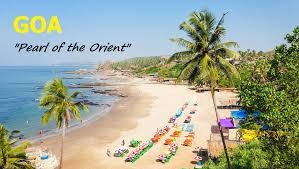Which Indian State is Known as the ‘Pearl of the Orient’?
India is a land of immense cultural, historical, and geographical diversity. Among its states, Goa holds a special place due to its rich heritage and stunning natural beauty. It is famously referred to as the ‘Pearl of the Orient,’ a title that encapsulates its unique charm and significance. This article delves into why Goa is known by this name, exploring its history, geography, and the factors that make it one of India’s most beloved states.
Why is Goa Called the ‘Pearl of the Orient’?
Goa’s title as the ‘Pearl of the Orient’ comes from its pristine beaches, rich colonial past, and significant role in global trade during the Portuguese era. The Portuguese, who ruled Goa for over four centuries, transformed it into a prominent trading post for spices, particularly pepper and cashew. This position in the international trade network brought immense wealth to the region, making Goa a ‘pearl’ in the eyes of the European traders. The state’s beautiful coastline, with golden sandy beaches bordered by the Arabian Sea, further adds to its allure, making it a tourist haven.
Cultural and Historical Significance of Goa
Goa has a unique blend of Indian and Portuguese cultures. The colonial legacy is reflected in its architecture, cuisine, and religious practices. The influence of Portuguese rule is visible in the churches, forts, and the vibrant festivals that continue to thrive in Goa today. The state is also known for its diverse population, including Hindus, Christians, and Muslims, who all contribute to the multicultural fabric of the region.
Goa’s Economy: A Major Contributor to India’s Growth
Apart from its historical and cultural significance, Goa is also an important economic player. Tourism is the primary industry, with millions of visitors flocking to the state each year to enjoy its beaches, wildlife, and Portuguese-influenced heritage. Additionally, Goa’s economy is bolstered by mining, fishing, and agriculture, particularly the cultivation of cashews and coconuts.

Why This News is Important: Understanding Goa’s Global Influence
Goa as a Cultural Gem of India
Goa’s designation as the ‘Pearl of the Orient’ reflects its importance not only within India but also on the global stage. As a region that has historically been a confluence of cultures, Goa’s unique identity makes it an important subject of study for students preparing for various competitive exams, particularly in the fields of history, geography, and economics.
Goa’s Role in International Trade
For students studying international relations, the economic history of Goa offers insights into the colonial trade networks and the role of European powers in the Indian subcontinent. Understanding Goa’s historical significance provides crucial context for the dynamics of global trade in the past centuries.
Goa’s Contemporary Relevance
In modern times, Goa continues to play a vital role in India’s economy, particularly through tourism. As an exam topic, it helps students understand how regions with a rich historical background can evolve into significant economic contributors. This news also sheds light on India’s evolving tourism industry, a major part of its services sector.
Historical Context: Goa’s Colonial Past and Economic Significance
Goa was an integral part of the Portuguese empire for over four centuries, from 1510 to 1961. During this period, the Portuguese not only built magnificent churches and forts but also developed Goa into a major center for trade, particularly in spices like pepper, which were highly coveted in Europe. The region’s location along the Arabian Sea facilitated its access to international maritime routes, further enhancing its role in global commerce.
In the 20th century, Goa became a focal point in the struggle for Indian independence, as the Portuguese resisted pressure to relinquish control over the territory. It was only in 1961 that Goa was liberated and incorporated into the Indian Union after military intervention. Despite its relatively small size, Goa’s long history and strategic importance have contributed to its reputation as the ‘Pearl of the Orient.’
Key Takeaways from “Goa: The Pearl of the Orient”
| Serial No. | Key Takeaway |
|---|---|
| 1. | Goa is referred to as the ‘Pearl of the Orient’ due to its historical significance in global trade, especially in spices. |
| 2. | The Portuguese ruled Goa for over 450 years, influencing its culture, architecture, and religious practices. |
| 3. | Goa is known for its stunning beaches, making it one of India’s top tourist destinations. |
| 4. | Goa’s economy thrives on tourism, mining, agriculture, and fishing, contributing significantly to India’s GDP. |
| 5. | Goa’s historical role as a trading hub and its colonial past make it an important subject for competitive exam preparations. |
Important FAQs for Students from this News
1. Why is Goa called the ‘Pearl of the Orient’?
Goa earned the title ‘Pearl of the Orient’ due to its strategic importance in international trade, especially during the Portuguese colonial period. The Portuguese established Goa as a major trade center for spices like pepper and cashews. Its pristine beaches and rich cultural heritage further contributed to this title.
2. What is Goa’s historical significance in India?
Goa holds historical significance as a former Portuguese colony, which lasted for over four centuries. The state’s colonial legacy is visible in its architecture, religious practices, and festivals. Goa played a central role in international trade, particularly in the spice trade.
3. What are the key industries that drive Goa’s economy today?
Goa’s economy is primarily driven by tourism, agriculture (including cashew and coconut farming), mining, and fishing. The state’s picturesque beaches, colonial architecture, and vibrant culture make it a popular tourist destination.
4. How did Goa become a part of India?
Goa was liberated from Portuguese rule in 1961 after a military intervention by India. It became a part of the Indian Union following the operation, ending over 450 years of Portuguese colonization.
5. What role does Goa play in India’s tourism sector?
Goa is one of India’s top tourist destinations due to its beautiful beaches, historic churches, and vibrant festivals. Its rich culture, which blends Indian and Portuguese influences, attracts millions of visitors each year, contributing significantly to India’s tourism industry.
Some Important Current Affairs Links


















